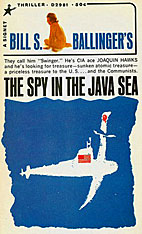I’ve asked Chuck Harter, the author of the following book to tell us more about it. He’s most graciously agreed:

CHUCK HARTER – Mr. Novak: An Acclaimed Television Series. Bearmanor Media, hardcover, softcover and eBook, illustrated, 15 October 2017.
This book is a comprehensive look at a classic dramatic television series that aired for two seasons in the early 1960’s. It was filmed at the MGM studios, aired on the NBC network and showcased life at a typical American High School.
The program starred James Franciscus as teacher John Novak with first Dean Jagger then later Burgess Meredith as the Principal of the school. Mr. Novak was the first series that portrayed teachers and students in a realistic dramatic manner.
Previously there had only been sitcoms which didn’t reflect the lifestyles of the real students of America. The series featured top quality scripts, actors and production and won over 47 awards during its run including the prestigious Peabody Award for excellence.
Many of the awards came from academic institutions which praised the show for its portrayal of the educational community. Such was the impact of the production that it prompted many to become teachers and many existing educators to improve their skills.

The book traces the evolution of the series from development to the pilot’s production and acceptance by NBC. It then covers the filming and airing of the first season to great acclaim.
The second season, which was fraught with controversy and discord is then examined with the result being cancellation.
The legacy of the principals involved with the series is examined along with comments by those that continue to be interested in this vintage classic dramatic series of superior values.

The book contains exclusive interviews with over 40 actors including Ed Asner, Frankie Avalon, Diane Baker, Beau Bridges, Johnny Crawford, Tony Dow, Sherry Jackson, Tommy Kirk, Walter Koenig, Martin Landau, June Lockhart, Beverly Washburn and many others. There are 243 illustrations and an index, including a complete episode guide with full credits, plot descriptions, vintage interviews, and new appraisals by the author.
There is also an extensive appendix with a list of the awards Mr. Novak won, Producer E. Jack Neuman’s writer’s guide for Mr. Novak, An advice column for High School graduates by star James Franciscus, Principal Vane’s (Dean Jagger) speech to the new teachers, the Mr. Novak board game and more.
The Introduction of the book is by A-List Director Richard Donner: “I’m so glad Chuck Harter is brining the Mr. Novak experience to a wider audience…read his detailed behind-the-scenes account.â€

The Foreword is by the late Martin Landau: “Chuck Harter has produced a superlative book that is both fascinating and informative.â€
The Afterword is by Star Trek actor Walter Koenig: “You don’t have to be an actor…just a student to appreciate the skillful way in which Chuck Harter unfolds the stories behind the cameras.â€
Mr. Novak was a television series of exceptional quality and the amazing thing is that when episodes are viewed today — they are not dated or corny but are still relevant to modern times.
The book is also available at Amazon.com, while the Official website is https://mrnovakbook.com/
ANNOUNCEMENT : Warner Home Video is going to release the first season of Mr. Novak (30 episodes) in a DVD set in 2018. They will be struck from the original 35mm camera negatives and should look pristine.
